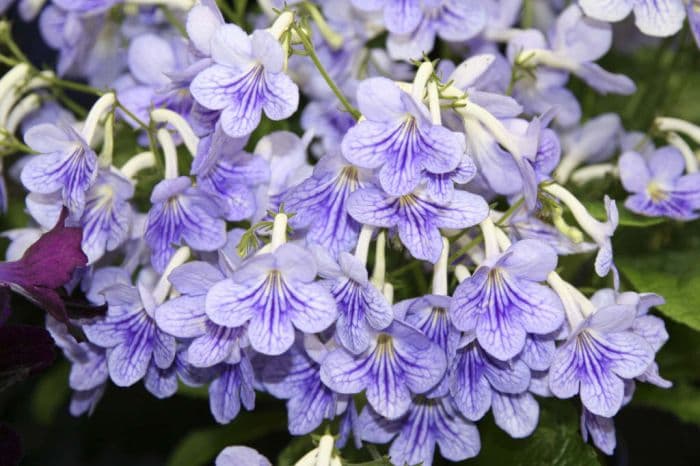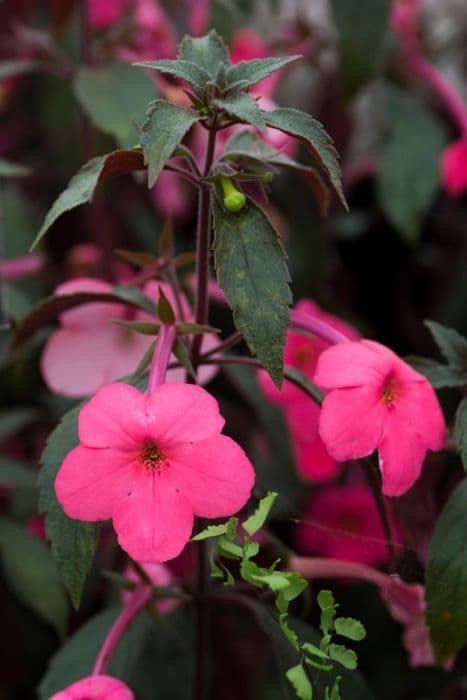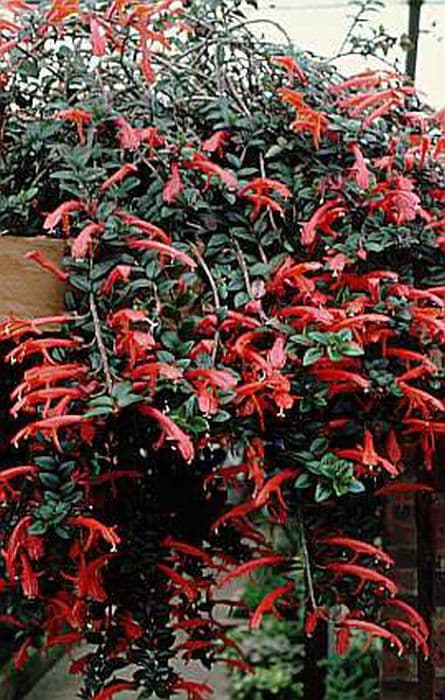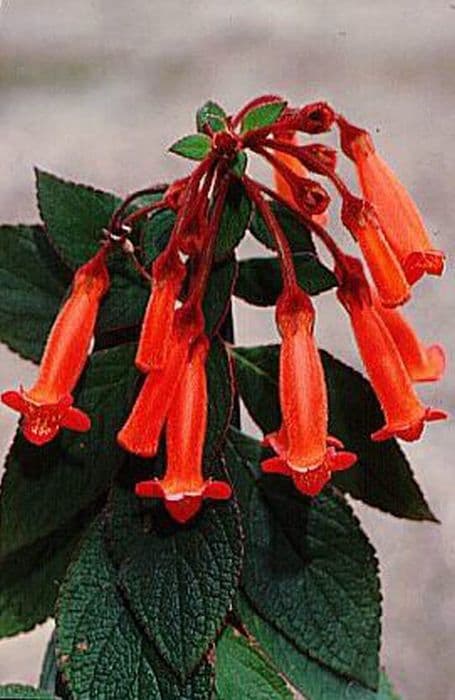Cape Primrose Streptocarpus 'Bethan'

ABOUT
Streptocarpus 'Bethan' is a flowering plant that bears a distinctive, attractive appearance. It produces lush, deep green, velvety leaves that have a soft, textured surface. These foliage elements typically grow in a rosette or a cluster, providing a dense and substantial base for the blooms. The flowers emerge on slender, delicate stems that rise above the rosette of leaves, giving the plant a layered look. The blossoms themselves are the stars of the show, often appearing in a trumpet-like shape that is characteristic of the Streptocarpus family. The petals of 'Bethan' are notable for their vivid colors, which can range from deep purples and blues to pinks and whites, often featuring intricate patterns, such as streaks, spots, or contrasting edges that add to the visual interest of the plant. These colorful displays are complemented by a yellow or white throat inside the flower, providing a striking contrast and drawing in pollinators. Streptocarpus 'Bethan' typically has a long blooming period, with the potential for flowers to appear throughout the growing season, which allows for a continuous display of its showy blossoms. The overall form of the plant is graceful, with a balance between the lush foliage and the delicate, colorful flowers that make it a desirable plant for indoor decoration and collectors of ornamental flora.
About this plant
 Names
NamesFamily
Gesneriaceae.
Synonyms
Cape Primrose, African Violet.
Common names
Streptocarpus 'Bethan'.
 Toxicity
ToxicityTo humans
Streptocarpus 'Bethan', commonly known as Cape Primrose, is generally considered non-toxic to humans. Ingestion of this plant typically does not result in poisoning or serious illness. However, as with any non-food plant, consumption is not recommended, and it is always possible for individuals to have allergic reactions or sensitivities. If any part of the plant is ingested and adverse symptoms are experienced, medical advice should be sought.
To pets
Cape Primrose, generally, is not toxic to pets such as cats and dogs. If a pet were to ingest parts of this plant, it is unlikely to cause poisoning or severe illness. Mild gastrointestinal upset might occur if consumed in large quantities, but significant toxicity is not expected. However, to ensure safety, it is always best to keep houseplants out of reach of pets, and if any abnormal signs are observed after ingestion, a veterinarian should be consulted.
 Characteristics
CharacteristicsLife cycle
Perennials
Foliage type
Evergreen
Color of leaves
Varies
Flower color
Mixed
Height
1 foot (30 cm)
Spread
1 foot (30 cm)
Plant type
Herb
Hardiness zones
10
Native area
Africa
Benefits
 General Benefits
General Benefits- Easy to Care For: Streptocarpus 'Bethan', commonly known as Cape Primrose, is low maintenance and does not require frequent watering, which makes it ideal for busy or forgetful gardeners.
- Long Blooming Period: The Cape Primrose has a lengthy flowering time, often blooming for months on end, providing continuous color and interest in indoor spaces.
- Attractive Foliage: With its velvety leaves and a rosette form, Cape Primrose adds a lush, green aesthetic to interior spaces even when not in bloom.
- Color Variety: The flowers of Cape Primrose come in a wide range of colors, which can enhance the visual appeal of any room.
- Compact Growth: Its compact size makes it an excellent choice for windowsills, desks, and small living areas where space is limited.
- Non-Toxic: Cape Primrose is generally considered non-toxic, making it a safer option for households with pets or small children.
 Medical Properties
Medical PropertiesThis plant is not used for medical purposes.
 Air-purifying Qualities
Air-purifying QualitiesThis plant is not specifically known for air purifying qualities.
 Other Uses
Other Uses- Photography Prop: Streptocarpus 'Bethan', also known as Cape Primrose, can be used as a beautiful prop in macro photography or as a subject in botanical art due to its vibrant flowers and unique foliage.
- Educational Tool: It can serve as a live specimen for botany students or enthusiasts to study plant anatomy, especially the characteristic pattern of its leaves and floral structure.
- Craft Inspiration: The intricate patterns of Cape Primrose flowers can inspire designs for crafts such as embroidery, fabric patterns, and other decorative arts.
- Culinary Garnish: Although not commonly consumed, the non-toxic flowers of Cape Primrose may be used as an edible garnish to elegantly decorate desserts or cocktails.
- Palette Inspiration: Artists may use the wide range of colors found in Streptocarpus 'Bethan' flowers as inspiration for color palettes in various forms of artwork.
- Humidity Indicator: Because it thrives in humid conditions, a Cape Primrose could potentially serve as a natural indicator for adequate humidity levels in a home or greenhouse.
- Companion Planting: Streptocarpus 'Bethan' can be placed among other plants that prefer similar light and water conditions to create a visually appealing and compatible plant grouping.
- Creative Writing Prompt: The exotic appearance of the plant could act as a muse or setting element in works of fiction, especially in fantastical or alien landscape descriptions.
- Therapeutic Art: Painting or drawing Streptocarpus 'Bethan' may offer a therapeutic benefit for individuals looking for a relaxing and creative outlet.
- Seasonal Celebrations: Its colorful flowers can be used in table settings or décor for certain spring or summer-themed events and celebrations.
Interesting Facts
 Feng Shui
Feng ShuiThe Cape Primrose is not used in Feng Shui practice.
 Zodiac Sign Compitability
Zodiac Sign CompitabilityThe Cape Primrose is not used in astrology practice.
 Plant Symbolism
Plant Symbolism- Persistence: Streptocarpus, also known as Cape Primrose, often symbolizes persistence due to its ability to bloom in less than ideal conditions and continue flowering for long periods.
- Endurance: The robustness of Cape Primrose in various environments also signifies endurance and the ability to thrive through challenges.
- Adaptability: This plant can adapt to different lighting conditions, which makes it a symbol of adaptability and flexibility in life.
- Optimism: With its bright and cheerful flowers, Cape Primrose denotes a sense of optimism and looking toward the bright side of life.
 Water
WaterCape primrose (Streptocarpus 'Bethan') prefers consistent moisture, so it's crucial to water it when the top inch of soil feels dry. Typically, this might mean watering every 5 to 7 days, but this can vary based on environmental factors like temperature and humidity. When watering, use lukewarm water and add enough so that it begins to run through the drainage holes, which could be approximately 8-16 ounces, depending on the size of the pot. Ensure excess water is drained to avoid waterlogging, which can lead to root rot. During winter or in lower light conditions, reduce the frequency to prevent overwatering.
 Light
LightCape primrose thrives in bright, indirect light, which promotes lush foliage and optimal blooming. A north-facing window or an east-facing window with filtered morning light could be ideal spots for the plant. Avoid placing it in direct sunlight, especially during the hot afternoon hours, to prevent leaf scorch. Consistent, but not overpowering light is key to the health of the Cape primrose.
 Temperature
TemperatureCape primrose fares best in conditions that mimic its native environment, with ideal temperatures ranging between 60°F and 75°F. It should be protected from temperatures that drop below 50°F or soar above 80°F to prevent stress and damage. Keeping the plant in a room where the temperature remains consistent and avoiding drafts, heaters, and hot appliances will help maintain the right temperature for growth.
 Pruning
PruningRegular pruning of the Cape primrose encourages a bushier growth habit and promotes more blooms. Remove spent flowers and yellow or damaged leaves to direct the plant's energy into new growth. The best time for pruning is immediately after a bloom cycle, as this can often stimulate another round of flowering. Pruning every 2 to 3 months or as needed can help maintain the plant's shape and vigor.
 Cleaning
CleaningAs needed
 Soil
SoilCape primrose prefers well-draining soil with high organic matter content. A mix of peat, perlite, and vermiculite in equal parts works best. The ideal soil pH for Cape primrose is slightly acidic to neutral, around 6.0 to 7.0.
 Repotting
RepottingCape primrose should be repotted every 1 to 2 years or when it becomes root-bound. Since they have a shallow root system, they prefer smaller pots and benefit from fresh soil to replenish nutrients.
 Humidity & Misting
Humidity & MistingCape primrose thrives in moderate to high humidity levels, ideally between 50% and 70%. They benefit from increased humidity but do not tolerate wet foliage well.
 Suitable locations
Suitable locationsIndoor
Ensure bright indirect light, keep soil moist.
Outdoor
Shelter from direct sun; protect from frost.
Hardiness zone
10-11 USDA
 Life cycle
Life cycleStreptocarpus 'Bethan', commonly known as Cape primrose, begins its life as a seed germinating in moist, well-drained soil, often in warm and shaded conditions. Once the seedling emerges, it develops a rosette of leaves and grows vegetatively, primarily in the spring and summer months. After maturation, which takes several months, the plant produces blooms typically in the spring or summer, featuring velvety, trumpet-shaped flowers. The flowering period can extend for several months, during which time the plant may be propagated through leaf cuttings to produce new plants. Cape primrose enters a dormancy phase in the fall and winter, which is a period of reduced growth, with some lower leaves dying back. With proper care, the plant can live for several years, and after the flowering season, seeds may be collected for future sowing, completing the cycle.
 Propogation
PropogationPropogation time
Spring-Early Summer
The popular method of propagating Streptocarpus 'Bethan', which is commonly known as Cape Primrose, is leaf cuttings. This can be done at any time but is most successful during the warmer growing season, typically in spring or early summer. Take a healthy leaf and cut it into sections, ensuring each section has a vein. Place the cut side down into a mixture of peat and perlite or a similar well-draining medium. Keep the soil moist but not waterlogged and in a warm spot with indirect light. Roots and new shoots typically develop within a few weeks to a couple of months, after which they can be potted up into individual containers.









